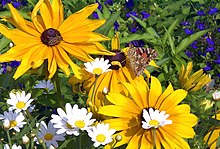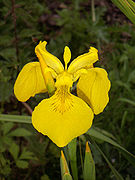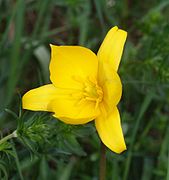flower
This article has been registered in the quality assurance biology for improvement due to formal or content-related deficiencies . This is done in order to bring the quality of the biology articles to an acceptable level. Please help improve this article! Articles that are not significantly improved can be deleted if necessary.
Read the more detailed information in the minimum requirements for biology articles .
A flower (from Old High German bluoma , from Indo-European bhlô , “to bloom, to appear”) describes in everyday language either a flowering plant that “produces” larger, eye-catching flowers , or a “single flower of a flower with a stem” or becomes used as a short form for flower stick. It is often used as jewelry, e.g. B. as a cut flower in a bouquet , as a flower wreath or flower arrangement. In the fine arts , flowers as a floral motif are a common theme.
In botany, however , the term flower is clearly defined and is particularly separated from the term blossom. While the flower (as a single flower or inflorescence) is defined by its function in pollination , a flower (as a compressed shoot with metamorphosed leaves) is a term that is clearly defined by its morphology .
Definition in botany and differentiation from flowering

1. flower base (Receptakulum)
2. sepals (sepals)
3 petals (petals)
4. stamens (stamens)
5. stamp (pestle)
A flower is the pollination-biological unit of the flowering plants . It is their job to attract pollinators, or they form a technical-functional unit. So flower is an ecologically- functionally defined term. Flowers pollinated by animals are classified according to their pollinators, such as bird flowers or beetle flowers .
A flower is defined as a sprout of limited growth in the service of sexual reproduction . Their structure is clearly divided into the flower envelope , stamens and carpels . Tulips or rose blossoms are good examples of this. They do not have to be conspicuously built or colored; and grasses have flowers.
Relationship between blossom and flower
- A flower can contain several flowers, as is the case with the iris species . Here each of the three sides is an attraction unit ( meranthium ) for the pollinators.
- A blossom can be exactly one flower (euanthium), as is the case with orchids , primroses or poppies .
- A flower petals may consist of several compositions ( Pseudanthium ), for example, the basket at Compositae such as sunflower . Here all the flowers act together as an attraction and serve as a landing place for the pollinators.
- In addition to the flowers, bracts can also be used to build the flower, such as the cyathia of the milkweed family or the kettle traps of the arum family . In the latter, the pollinators are kept captive within the bract to ensure pollination.
Three flowers in a bloom on the flag of the iris
The blossom, at the same time a flower, of the wild tulip
A flower from many flowers in Sunflower
A flower made of many blossoms in the poinsettia . Not the flowers are strikingly colored, but the bracts
A flower made of many blossoms in the spotted arum . A bract forms the kettle trap .
Flower types
Different types of flowers are distinguished according to the shape of the flowers. The flower type is closely related to the respective pollinator:
- Disk and bowl flowers are flat, access to the center of the flower is not restricted. They are mainly visited by pollen-eating beetles. One example is the corn poppy .
- The cup flowers or bluebells are increasingly narrowed and form a funnel or cup. Example are crocuses .
- Tubular flowers usually have a longer, rather narrow corolla tube, or a longer and narrower, tubular, funnel than the cup flowers or bell flowers. They are not to be confused with the tubular flowers of the daisy family .
- Platter flowers have a narrow, often long tube on which the flat, disc-like corolla lobes sit, examples are the carnations .
- In the spur flowers, the nectar is hidden in a spur , an example is the violet .
- The revolver flower has several entrances, chambers to the nectar, examples are Gentiana acaulis or the thorn apples ( Datura )
- In throat flowers, the pollinators crawl deep into the flower through a relatively large, wide throat.
- In the case of lip flowers, the flower is clearly divided into two parts, with the lower lip serving as a landing area for the pollinators. Examples are those of the mint family and mint family . When the large lower lip of the flower is pulled over the upper lip and the throat is closed, it is called one
- Mask flower (often also throat flower): the closure (the mask) has to be opened by the weight of the pollinator by landing on the large lower lip and pressing it down. Examples are toadflax and snapdragon .
- Brush flowers have numerous stamens that are stretched out of the flower in the shape of a brush or brush. Examples are the acacia and willow inflorescences .
- Fall flowers temporarily enclose the pollinators. Sub-types are clamp traps ( Asclepias ) and sliding traps ( Arum ).
- In the case of flag flowers, the adaxial side of the inflorescence is conspicuous, greatly enlarged, a flag . One example is the butterfly flower .
- Special forms
- False flowers ( pseudanthium )
- With the cup and head flowers, several individual flowers are grouped together in a round or disc-shaped inflorescence so closely that the flower head looks like a single blossom.
- In piston flowers, the small individual flowers sit on a thick, fleshy, club-shaped axis, so that a piston-like inflorescence is created.
- The umbrella flowers (umbel flowers ) are named because of their resemblance to an umbrella.
- Pollen flowers have flowers that exclusively or predominantly offer pollen as food for flower visitors. They have many anthers that produce plenty of pollen; this is then usually easily accessible.
- Nectar flowers; Plants that excrete nectar for pollinating animals in the nectar glands of their flowers.
- Deceptive flowers are blossoms that simulate something to visitors (pollinators), which entices them to visit, but in reality is not there at all, either by exploiting their foraging, egg-laying or sexual behavior.
- Oil flowers are flowers that secrete fatty oils instead of nectar from special tissues ( elaiophores ). The oils (flower oils) are collected by specific bees ( oil bees ).
- Perfume flowers (mainly orchid species) are completely nectar-free, they are flowers that only dispense liquid fragrances or scented oils.
- Disgust or carrion flowers whose petals carrion smell emanating to carrion flies to pollinate the flower to attract. Other forms that produce smells of attacked, trapped or dead insects are possible.
- Others are wasps, flies, butterflies, bird flowers and z. B. beetle flowers, snail flowers or reptile flowers that are specifically adapted to the pollinator. → Entomophilia , zoophilia (botany)
- False flowers ( pseudanthium )
In accordance with the adaptation to the pollinators, the flowers form characteristic syndromes, which are called flower styles. They are discussed in more detail under the individual forms of pollination . Examples are bird flowers , bee flowers .
size
The largest flower on earth is formed by the titan arum ( Amorphophallus titanum ) and is over two meters high, the largest flower on earth ( Rafflesia arnoldii ), on the other hand, is formed by a plant species of the Rafflesia family and is about one meter wide.
Transferred
- In flower language , flowers are arranged in a bouquet according to color and shape so that a message is included.
- Said through the flower denotes a form of concealing a negative statement by glossing over words.
- The artificial flower is a decorative element made of synthetic or natural material, which is shaped as a flower arrangement and lasts longer than a bouquet.
- The beer flower is a flower in the figurative sense, whereby the upper creamy-white connection above the yellow drink is compared with the beautiful (botanical) shape.
literature
- Peter Coats: Flowers in history. New York 1970.
- MV Strantz: The flowers in legend and history. 1857.
Individual evidence
- ↑ Etymological dictionary of the German language : Blume , Blust .
- ↑ a b c flower that. Duden , accessed on November 18, 2016 .
- ^ Rudolf Schubert and Günther Wagner: Plant names and botanical terms. Botanical lexicon with an introduction to terminology and nomenclature, a list of the authors' names and an overview of the plant system. 6th edition. Melsungen / Berlin / Basel / Vienna 1975, p. 89.
- ^ Hunnius Pharmaceutical Dictionary . 6th edition. Walter de Gruyter, Berlin / New York 1986, ISBN 3-11-007029-4 , p. 167 f.
- ^ P. Sitte, EW Weiler, JW Kadereit, A. Bresinsky, C. Körner: Strasburger - textbook of botany for universities . 35th edition, Spektrum Akademischer Verlag, Heidelberg 2002, ISBN 3-8274-1010-X , p. 773.
- ↑ Peter Leins: Blossom and Fruit. Morphology, history of development, phylogeny, function, ecology. E. Schweizerbart'sche Verlagsbuchhandlung, Stuttgart 2000, ISBN 3-510-65194-4 , pp. 182-187.
- ↑ Flower types - flower shapes - shape types on garten-treffpunkt.de, accessed on October 9, 2019.
- ↑ Hans Kugler : Flower ecology. 2nd edition, Urban & Fischer, 1970, 1990, ISBN 978-3-437-20037-3 (reprint), p. 32.
- ^ Johann Georg Krünitz : Economic Encyclopedia. Volume 144, Pauli, 1826, p. 621.
- ↑ Heinz Ellenberg, Karl Esser u. a .: Advances in botany. Volume 30, Springer, 1968, ISBN 978-3-642-95021-6 , p. 35.
- ^ Margreth Kielmann (2013): Generative propagation of Amorphophallus johnsonii by hand pollination. The Palm Garden 77: 17–23.






